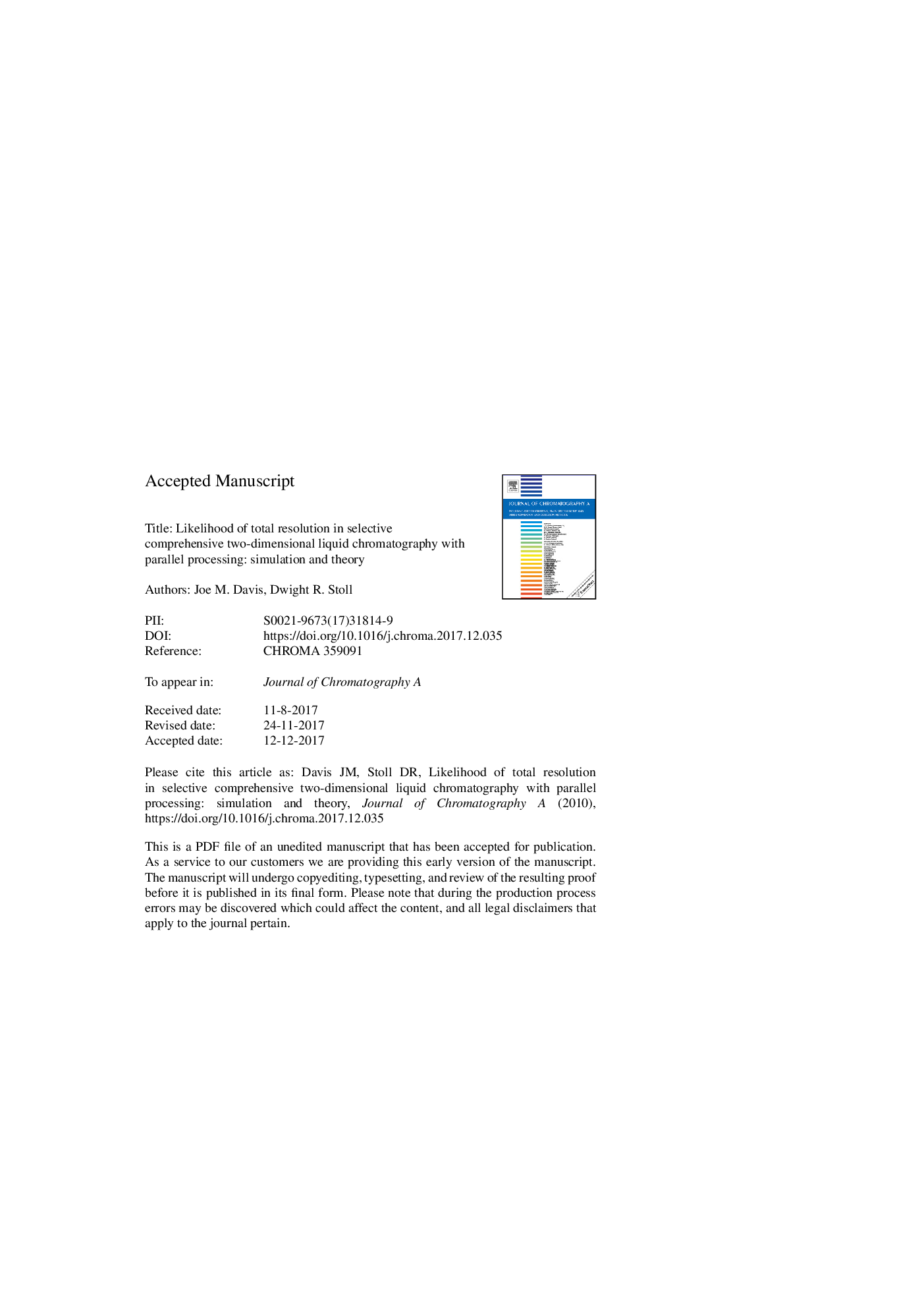| کد مقاله | کد نشریه | سال انتشار | مقاله انگلیسی | نسخه تمام متن |
|---|---|---|---|---|
| 7608813 | 1493389 | 2018 | 51 صفحه PDF | دانلود رایگان |
عنوان انگلیسی مقاله ISI
Likelihood of total resolution in selective comprehensive two-dimensional liquid chromatography with parallel processing: Simulation and theory
ترجمه فارسی عنوان
احتمال رضایت کامل در کروماتوگرافی مایع جامد دو بعدی جامع با پردازش موازی: شبیه سازی و تئوری
دانلود مقاله + سفارش ترجمه
دانلود مقاله ISI انگلیسی
رایگان برای ایرانیان
موضوعات مرتبط
مهندسی و علوم پایه
شیمی
شیمی آنالیزی یا شیمی تجزیه
چکیده انگلیسی
The probability Pr(sLCÃLC) that all peaks are separated by a resolution of 1.5 or more in selective comprehensive two-dimensional liquid chromatography (sLCâ¯Ãâ¯LC) is computed for simple model systems of 5 to 60 peaks and first-dimension (1D) gradient times of 100 to 2000â¯s. The computations include mimics of a commercial instrument, whose fixed second-dimension (2D) gradient time and use of one cycle time for initialization reduces Pr(sLCÃLC) relative to an earlier report. For serial sLCâ¯Ãâ¯LC, in which a single device collects and transfers 1D multiplets to the second dimension, Pr(sLCÃLC) under practical conditions is predicted to be only slightly larger than the probability of total resolution in LCâ¯Ãâ¯LC for separations of the same duration in each case. To increase Pr(sLCÃLC), two model systems are proposed based on parallel processing, in which one device collects multiplets from the first separation while a second device simultaneously transfers fractions from previously collected multiplets to the second dimension for further separation. A sum of probabilities guideline is proposed by which optimal fixed 2D gradient times, ranging from 9.5 to 12â¯s, are found for both serial and parallel models. The increases of Pr(sLCÃLC) based on parallel processing are modest; the largest is only 0.062 for one system and 0.106 for the other, relative to the serial model. A theory is derived that rationalizes the modesty of the increase, which was unexpected. It shows that Pr(sLCÃLC) equals the probability of total resolution in the first dimension, plus the product of the probability that all 1D multiplets are transferred to the second dimension and the probability that all multiplets are separated in the second dimension. The theory shows that, although parallel processing is better than serial processing for multiplet transfer, the ability to leverage this gain is offset by the limited probability that all multiplets are then actually separated in the second dimension, which is only about 0.55 for conditions where the change from serial to parallel processing is most beneficial. With these findings in hand, two scenarios are examined for future consideration: one in which the 2D peak capacity is doubled, and another in which multiplets are always transferred to the second dimension. The latter shows considerable promise for increasing Pr(sLCÃLC) substantially beyond its counterpart in LCâ¯Ãâ¯LC. For example, a 50% probability of separating all peaks in a 15-component mixture can be reached in 1150â¯s using LCâ¯Ãâ¯LC. The same probability can be reached in the same time for a sample with nearly twice as many components (27) in the case of sLCâ¯Ãâ¯LC, assuming transfer of all multiplets to the second dimension. These findings will be useful to those considering systematic approaches to developing 2D-LC methods for moderately complex mixtures, and to those interested in instrument development for 2D-LC.
ناشر
Database: Elsevier - ScienceDirect (ساینس دایرکت)
Journal: Journal of Chromatography A - Volume 1537, 16 February 2018, Pages 43-57
Journal: Journal of Chromatography A - Volume 1537, 16 February 2018, Pages 43-57
نویسندگان
Joe M. Davis, Dwight R. Stoll,
